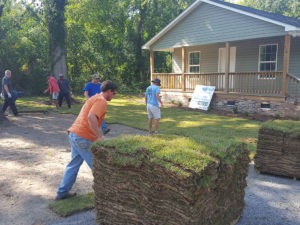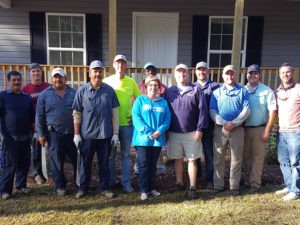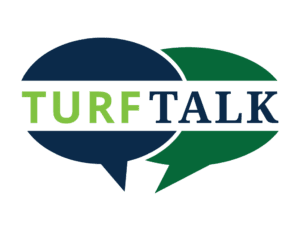
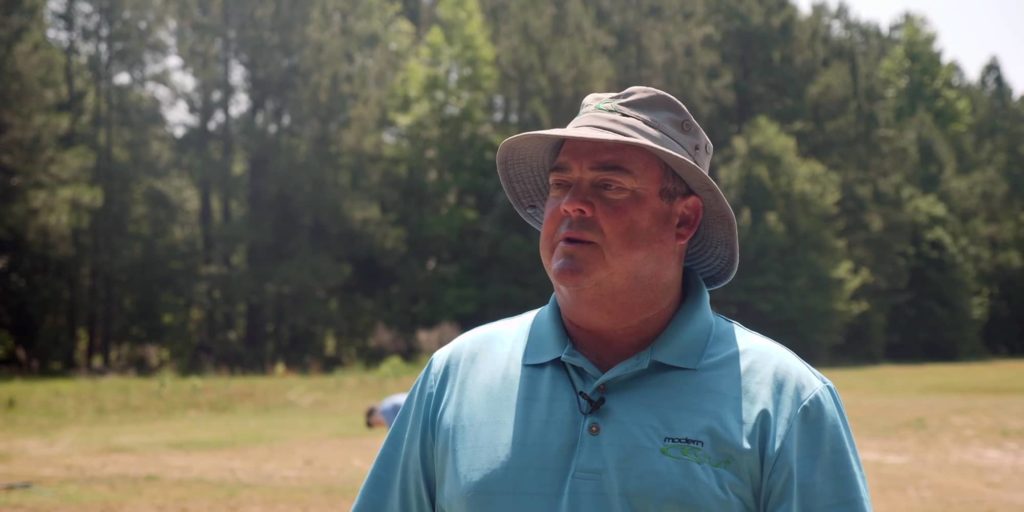
Behind the Curtain at Modern Turf: Hank Kerfoot
Hank Kerfoot comes from a golf-rich family background. His father, who is in his late 80’s, is an accomplished golfer that went to Wake Forest and played golf with Arnold Palmer. Kerfoot grew up as a caddy for his dad at their local country club in Arlington, VA.
“I just grew up around golf grass. I started mowing lawns when I was 12 and started caddying when I was 12. I started working on a golf course when I was 15 and just always have had a little bit of a green thumb,” Kerfoot said.
He said he barely graduated high school, let alone with a diploma and spent several years after graduating trying his hand in different careers. From cooking to installing computer cables in old buildings in Washington, D.C. to working on golf courses, Kerfoot was looking for the right fit.
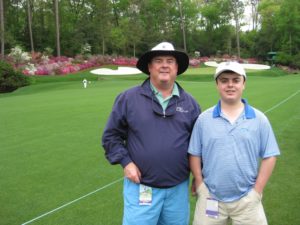
Kerfoot with son Henry at Augusta National
“I just kept coming back to golf courses,” he said. He decided to take community college classes so universities would consider accepting him and ended up going to what at the time was called Lake City Community College in Lake City, Florida.
He said to even be enrolled at Lake City when he applied, there was a requirement you’d worked on a golf course for at least a year. “So, you couldn’t just graduate high school and decide you wanted to go into turfgrass, you had to have experience.” Kerfoot appreciated the fact that they shared and applied the knowledge from their experiences working on golf courses in the classroom and into real life.
He started the three-year program for the Associate of Science Degree in Golf Operations when he was 23 years old. At that time, Kerfoot had a lot of experience working on cool-season grasses in Virginia, Maryland and the Washington, D.C. area.
“By then I’d also worked as a bellman in the Florida Keys at the Ocean Reef Club. I’d had a little taste of the South and had decided that I felt like there was more golf for more days of the year the further south you went and more opportunities,” Kerfoot said. “I figured if I went to a Southern school and I had Northern experience then I could go anywhere.”
Kerfoot completed internships at TPC Avenel in the D.C. area and at TPC Prestancia in Sarasota, Florida. He worked at TPC Sawgrass all through college. His first job out of college was in Bermuda working as the assistant golf course superintendent at Port Royal Golf Course for three years. Next, he moved to Charlotte where he was the superintendent at Carmel Country Club for four years.
Then, Kerfoot got involved in building golf courses. He helped build Firethorne Country Club in Charlotte and rebuilt Smoky Mountains Golf Club in Whittier, N.C. He got involved with a company that was going to buy, build and manage golf courses in the Carolinas. As they were looking for projects, the company sent Kerfoot to Puerto Rico to put a sod farm in for a client there.
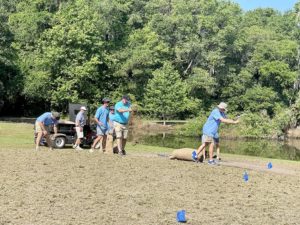
Hand sprigging greens
“To back up to when I was a golf course superintendent; I was always fascinated with new grasses. I would find them, I would plant them, I would try to kill them- which I’m apparently successful at. But I would just try to learn about it because it’s just my thing,” Kerfoot said. Kerfoot worked as an assistant superintendent and superintendent for almost nine years altogether between his various jobs with Port Royal and Carmel Country Club.
Sod Farming
As he was working on the course in Puerto Rico, Kerfoot started thinking about what was next for him in his career. He and his wife, Mary, started looking at some new opportunities, like maybe owning a mom-and-pop golf course in Myrtle Beach.
Kerfoot said he loved being a golf course superintendent but thought sod farming would be intriguing because he could use all his knowledge and contacts to help him as he started off. Also, he and his wife were starting their family at that time, so he was excited about switching to a job that allowed him more time spent with them instead of traveling for work. The Kerfoots have three children who are all young adults now: Henry, Sarah and Libby.
“We decided to look for some flat land in central South Carolina that had access to water and an interstate. We found the Rembert farm, our first farm and bought it in February 2000,” he shared.
After a few years they realized they needed more land. At that time Kerfoot was able to find another farm 10 miles down the road which he purchased.
Turfgrass Industry
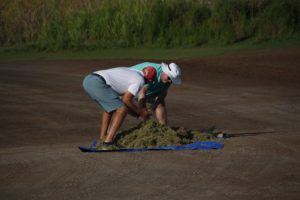
Kerfoot with grass sprigs
Kerfoot said for anyone who doesn’t understand the turfgrass industry, like with other industries, continuing education is a must. When he was in college and they had classes in the late afternoon explaining new varieties, many of his friends would skip and go out to the bar for a beer. But not Hank. Kerfoot said he was in the front row trying to learn about all the new grasses.
“I knew what Paspalum was before anybody could even say Paspalum,” he joked. “I was curious and just thought it was cool to hear the talks on new grasses.”
Kerfoot’s college roommate at Lake City Community College in Florida was John Holmes, president of Atlas Turf. He said that it’s pretty cool that they get to do business together. “The turfgrass industry is a small fraternity. If you’ve been around long enough, it’s pretty specialized. It’s highly intelligent people who are very motivated and very passionate about what they do,” he added.
He estimates maybe 15 of the guys he went to college with are still in the industry in golf or turfgrass. “I think the people that are in it for the long haul just have a genuine love for it,” he added.
Turfgrass Producers International
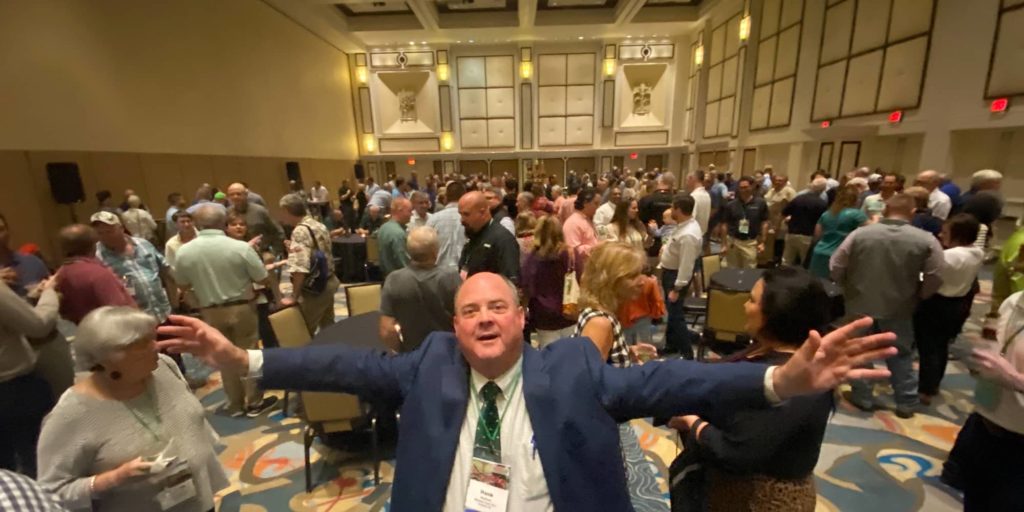
Turf Producers International Conference 2019
In his early days as a sod farmer, Kerfoot became involved with Randy Graff, founder of Graff’s Turf Farm in Colorado, who discussed raising the prices of sod. Then, he recalled attending his first SC Sod Producers meeting around that same time and hearing that they hadn’t raised the prices of sod in almost 20 years.
“I almost threw up because my business plan didn’t show that. As I became more involved, I ended up becoming the president of South Carolina Sod Producers and led it for almost 10 years straight,” he said.
Kerfoot said he was outspoken and enjoyed being involved. At his first Turfgrass Producers International (TPI) meeting, they tried to recruit him onto the board, but he felt like it was too early for him to contribute. Plus, he had three young children at the time and was getting his sod business up and running.
About ten years ago members started to recruit Kerfoot again to join TPI’s board. Now, he’s served on the executive committee, as president and as past president of the organization. He served as President of TPI for the February 2020 TPI conference in Orlando, Florida and his reign was through the COVID-19 pandemic. Now, his time on the board is nearing its end as the February 2022 TPI conference in San Diego, CA approaches.
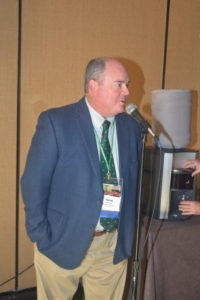
Kerfoot leading TPI
“It’s been a very enriching, very valuable process. One, to be able to contribute to the greater good of the sod-producing community but then also the personal payback and what you get through, meeting regularly with other industry leaders throughout the world, particularly in the US but Canada and internationally as well,” Kerfoot said.
He explained that serving on the board allowed him to broaden his horizons and enjoy being in a group whose goal is to make sod farmers comfortable sharing information with each other. He explained that when he was in the golf industry, everyone shared information with each other to make all better. He said he is trying to get that cooperation across in the sod industry, an industry that is more competitive because the farmers are essentially competing for the same dollar, in some sense.
“There’s a camaraderie but it’s not the same. But, when you go to TPI you can talk to a guy from Texas who grows the exact same grass as you do and you can talk about equipment, you can talk dollars and talk about things without feeling like you’re giving away your greatest trade secrets.”
He said that younger generations don’t always see the value in associations because they can get information and network online or through social media. Kerfoot is hopeful things come full circle and younger generations realize the human condition makes us want to be in a room with other humans.
“That’s the magic of TPI. We, as the board, always say if we can just get them to come to one annual conference and let them see, smell, touch, feel and be around the camaraderie and the actual education you get from other people. For me, in my background with turfgrass that’s been from day one,” he said.
Golf Specialization
Kerfoot was very involved in theater in both high school and college. He said when you look at professional golf tournaments, part of the appeal to him was the stage. The PGA Tour to him was like a great drama.
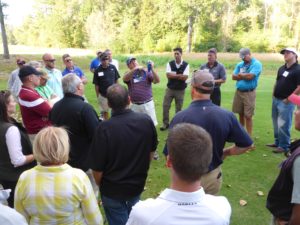
Kerfoot demonstrates a light measuring mechanism
“It’s impromptu and that you don’t know the outcome. It’s great theater, especially if you love the game and I have a deep love for the game (of golf),” he shared.
Being able to be outside and not in an office with four walls and being able to interact with people is something Kerfoot is very thankful for. His experience caddying and working on different golf courses allowed him to learn what that atmosphere was like. “I was very comfortable around the members and I just loved it. In the mornings and in the afternoons and just the peace of it all and the beauty of being outside.
“Also, the sensation of having really good greens. It all comes down to the greens. When you’re on a golf course you get judged by the putting greens. If you could manage the greens then the golfers were happy,” he said.
At Modern Turf, the core four employees (Hank, Randy Allen, Buddy Smith and B.J. Haunert) are all former golf course superintendents and a few other guys on staff worked on courses in the past as well.
“We’ve had more on staff before that were golf course superintendents before as well. It helps. We grow three different types of bermudagrasses and we all do installs ourselves and participate. Some of us have been doing it for 20 years and we aren’t getting any younger,” Kerfoot said.
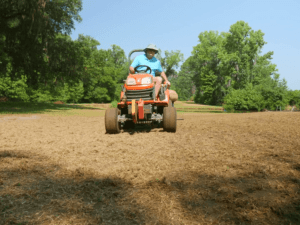
Kerfoot rolling Sunday Bermuda sprigging job
“You gotta have someone that can walk the walk and talk the talk on a golf course, in my opinion, to be able to go out there and have credibility. You need that when talking with them about fertility, chemicals and plants and benefits and all that. And not just for the golf course superintendent, but when you’re out there planting them it’s like Christmas Day for these clubs when they are getting new greens. Golf is about greens, no matter what anybody tells you it comes down to the greens,” he said.
Kerfoot said when they install new greens, it’s a great public relations opportunity for Modern Turf, even if the club has skilled laborers that could plant it without them because their staff knows the ins and outs of the grass. He said whether members or staff come out to help, their team has to know the lingo, know the ins and outs and how to maneuver around on the course properly with maintenance etiquette to make sure their tractors and trucks don’t mess up the course.
Kerfoot said that they’re going to eventually need to find younger leaders and supervisors with golf backgrounds to help with overseeing installs.
Research
Modern Turf is very innovative in the research side of the industry by being involved with research trials. Currently, the research plots at the farm consist of Celebration X, an ultra-fine zoysia study, Iron Cutter Bermuda, paspalums from the University of Georgia and the 14069 zoysia line from NC State University. Kerfoot explained they have planted Innovation™ Zoysia around those plots, as well as some Geo® Zoysia.

Sod Solutions Tobey Wagner, Kerfoot, Atlas Turf’s John Holmes and UF’s Dr. Kenworthy
He explained he has a big interest in testing new grasses but didn’t like just looking at what he considers car hood size sod plots. “To me, it just didn’t tell me enough.”
He started talking to Sod Solutions President Tobey Wagner, University of Florida Turfgrass Researcher Kevin Kenworthy, John Holmes with Atlas Turf and with JW Turf Farms in Florida to try and get bigger plots so they could take a better look at zoysias. “Whether we get a putting green variety out of them or not, I think it’s good exercise and I’m sure we’ll get something out of it.”
He believes allowing a harder look at a grass variety before it goes to production will help avoid issues in the future.
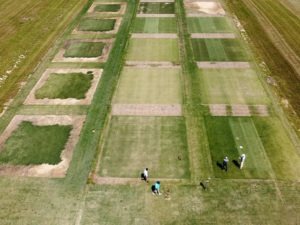
Research plots at Modern Turf
“To get out in front of it and take a little bit of ownership of the research and to get into it will hopefully yield us some reward at the end. Maybe not necessarily exclusive because that’s not always a good thing, I’ve learned that. But maybe at least a first right of refusal on something really good to have open up equity in would be a good thing.”
Kerfoot said you need good growers that you can trust to trade inventory with as well as being able to market a new grass well to consumers. “That’s one of Sod Solutions greatest strengths is the marketing. You gotta have three things: well-marketed grass, really good grass and really good people growing it.”
Community Involvement
Modern Turf has been a part of at least 10 First Tee projects, most of which Kerfoot donated sod for unless the projects were well-funded. They’ve done two First Tees in Tennessee, and several in North Carolina and South Carolina.
“I think everybody has to do that, no matter what industry you’re in. Everybody should have a sense of duty to their community to give back.
Every Saturday, Modern Turf donates a pallet of centipede grass to Food for the Soul, a local soup kitchen in Camden so they can sell it by the piece for profit. Then the volunteers from the soup kitchen sell each piece of sod for $2 and help load it into the buyer’s vehicles. He said this is just an easy way for them to give back that makes an impact towards meals.
Modern Turf has helped build around 20 Habitat for Humanity houses. He said they have volunteered to lay the sod they donate and other times they’ve just donated the sod and high schoolers that need service points have helped lay it at a home. “Laying sod for a Habitat House is not a huge undertaking.”
He is hopeful that when TPI travels to a big city for their conventions they will take time as a group to contribute or volunteer with a service project. Kerfoot also looks forward to staying involved with community service projects similar to the Sergeant Jasper Golf Course, a golf course revitalization project where he donated Sunday™ Ultra-Dwarf Bermudagrass greens and installation efforts in 2021. To learn more about Modern Turf, visit https://modernturf.com.
This article was written by Cecilia Brown.

